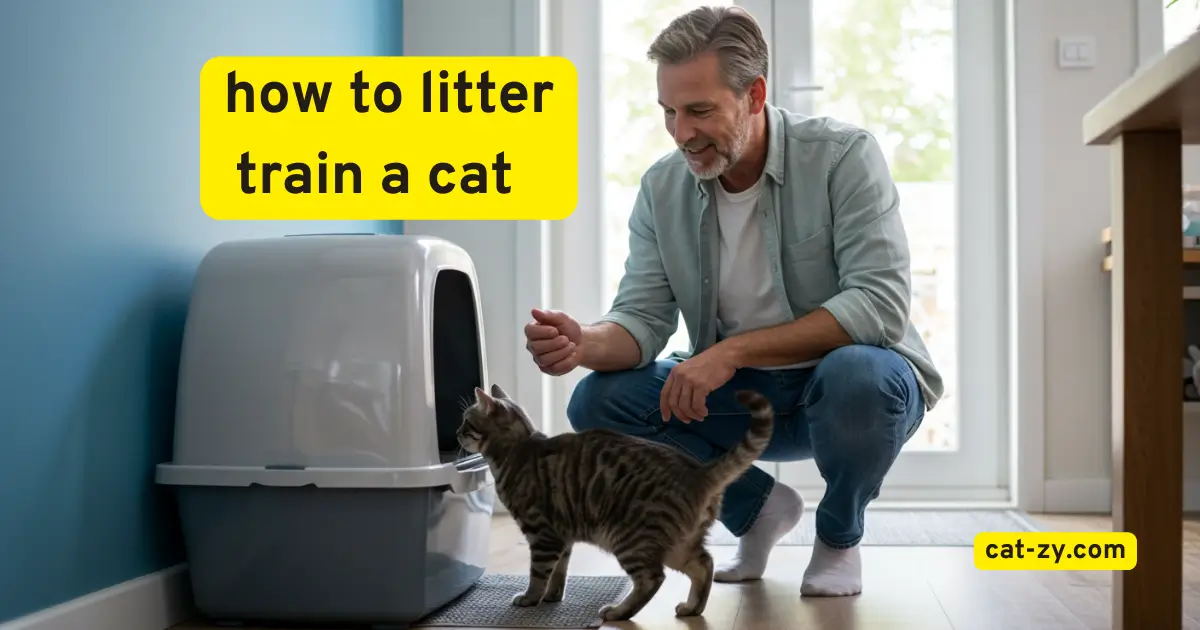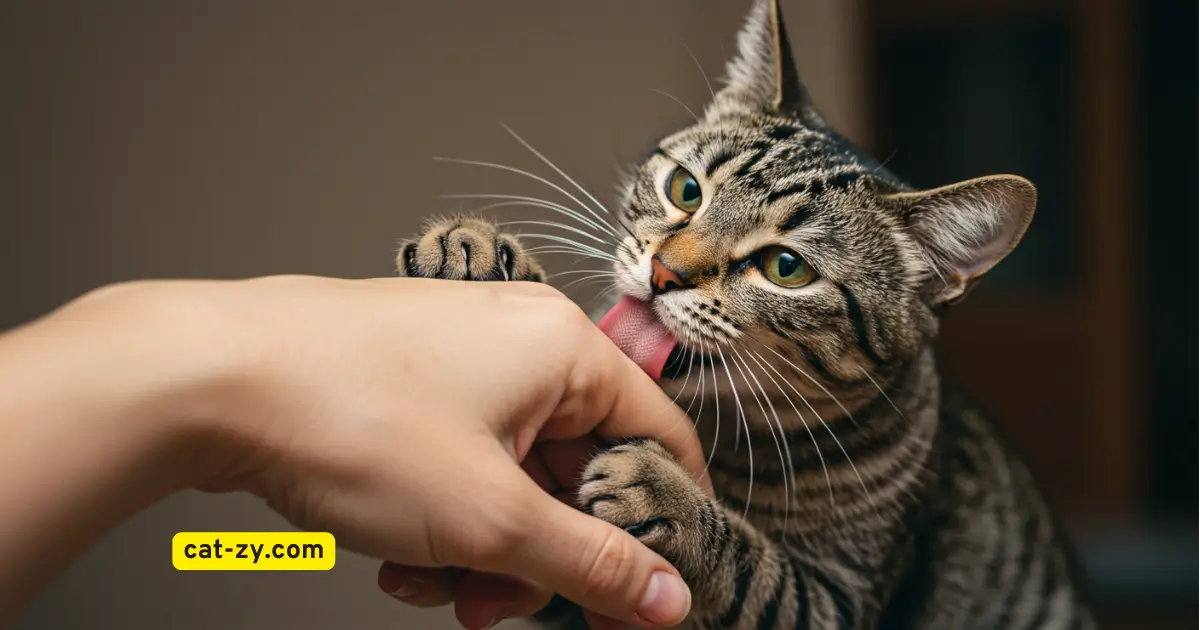How to Litter Train a Cat Fast: 5 Proven Methods
Are you tired of the hassle and mess of training your cat? Litter training is key for any cat owner. It can make a big difference in your daily life. With the right approach, you can transform your cat’s behavior quickly.
Good litter training improves your cat’s hygiene and strengthens your bond. In this article, we’ll look at five proven methods for successful litter training. By the end, you’ll know how to litter train your cat fast.
Table of Contents
Understanding Your Cat’s Natural Instincts
Knowing your cat’s natural behaviors is crucial for litter training. Cats have instincts that affect how they use the litter box.
Why Cats Naturally Seek Out Loose Substrate
Cats like loose substrate for digging and burying waste. This comes from their wild ancestors who hid their scent from predators. Loose litter feels like their natural environment, making it appealing to them. This instinct helps in litter training, as cats prefer a similar experience.
The Role of Scent in Territory Marking
Cats have scent glands on their faces, whiskers, and paws. They use these to mark their territory, including the litter box. Scent marking is key for cats to communicate and feel ownership. Knowing this helps choose the right litter and keep the litter box clean.
Age Considerations in Litter Training
A cat’s age plays a key role in how to litter train a cat effectively. Kittens learn from their mothers, while older cats need more patience. Understanding these age factors helps tailor training to your cat’s needs.
Essential Supplies for Successful Litter Training
Starting your cat’s litter training journey requires the right essential supplies. The right tools make training easier and keep your cat comfortable and stress-free.
Choosing the Right Litter Box
Finding the right litter box is key. Think about your cat’s size and your home’s space. A box that’s too small can scare your cat away. Choose one that’s at least 1.5 times your cat’s length.
For convenience and comfort, consider this highly rated litter box on Amazon that fits most cats and is easy to clean.
Consider if you want a covered or uncovered litter box. Covered boxes offer privacy but might trap smells. This could make them less appealing to your cat.
Selecting the Best Cat Litter
The litter you pick is very important. Cats have their own likes and dislikes when it comes to litter. You can choose from clumping clay, silica gel, recycled paper, or natural litters like pine or corn.
Clumping clay is good because it controls odors and is easy to clean. But, some cats don’t like its feel. Watch how your cat reacts to different litters and pick the best one for them.
Additional Helpful Tools
There are tools beyond the litter box and litter that can help. You’ll need a litter scoop and bags for daily cleaning. Some people also use litter mats to catch stray litter and keep the area clean.
How to Litter Train a Cat with the Perfect Litter Box Setup
The litter box’s location is very important. Cats like quiet, private spots for their business. Avoid placing it close to their eating and drinking areas. Cats don’t like to eat and go in the same place.
Make sure the litter box is easy to get to. This is especially important for older or mobility-challenged cats.
By focusing on these supplies and setup, you can help your cat learn to use the litter box quickly and well.
How to Litter Train a Cat: The Basics
To litter train your cat, start with the basics. It’s not just about a box with litter. It’s about making a space where your cat will use it often.
Proper Litter Box Placement
The litter box’s location is crucial. Put it in a quiet, easy-to-reach spot. Stay away from busy or noisy areas. It’s best in a private room or corner.
Think about your cat’s age and how it moves. For older or less active cats, a low-sided litter box or ramp is helpful.
How to Litter Train a Cat: First Steps to Success
Once the litter box is set up, start learning how to litter train a cat by introducing your feline friend to it. Place them in the box after meals or play. This links the box to its purpose. Let your cat explore the litter by sniffing and digging.
Creating a Consistent Routine
Consistency is key. Set up a routine for feeding, play, and cleaning the litter box. This makes your cat feel secure and helps them learn good habits.
Monitoring and Encouraging Proper Usage
Watch how your cat uses the litter box. If they avoid it or have accidents, fix it fast. When they use it right, praise them to encourage more of the same. Being attentive helps avoid litter training problems.
To master how to litter train a cat, always keep the litter box clean and odor-free. Cats are very clean and won’t use a dirty box.
5 Proven Methods for Fast Litter Training
Discover the best techniques on how to litter train a cat quickly with our expert tips. Litter training is key for cat owners. With the right methods, you can see fast results.
Method 1: The Gradual Introduction Technique
This method slowly introduces your cat to the litter box and litter. It helps your cat get used to the new environment without feeling overwhelmed.
Step-by-Step Implementation
Begin by putting your cat in the litter box after meals or play. Encourage them to dig and explore with their paws or a toy. Over time, increase the amount of time they spend in the litter box.
As they get more comfortable, give them more freedom in the house while watching them.
Expected Timeline
This technique usually takes 7-10 days to show results. Be patient, as every cat is different.
Method 2: The Confinement Method
This method keeps your cat in a small area with the litter box. It’s great for kittens or new cats in your home.
Setting Up a Safe Space
When figuring out how to litter train a cat, choose a quiet, comfy area for them. It should have food, water, and a litter box. Keep it clean and well-ventilated.
As you learn how to litter train a cat, gradually give them more freedom in the house as their litter habits improve.
Gradual Expansion of Territory
Start adding new rooms one at a time. Always watch your cat’s behavior as you expand their territory.
Method 3: The Positive Reinforcement Approach
Using positive reinforcement plays a crucial role in successfully training pets to use the litter box. Rewarding your cat for good behavior encourages them to keep it up.
Effective Reward Systems
Reward your cat with snacks, compliments, and loving attention. Clicker training can also help reinforce good behavior.
Be consistent with rewards and give them right after your cat uses the litter box.
Timing Your Rewards
When learning how to litter train a cat, timing is key. Reward your cat immediately after they use the litter box. This links the behavior with the reward.
Method 4: The Scent Transfer Technique
This technique uses your cat’s scent to make the litter box more appealing. It’s great for picky cats or those who have accidents outside the box.
Using Your Cat’s Natural Scent
Gently rub a cloth on your cat’s cheeks or near their scent glands. Then rub the cloth on the litter box. This transfers your cat’s scent, making the litter box more attractive.
Implementing Scent Transfer
Do this regularly, especially after cleaning the litter box. It keeps your cat interested in using it.
Method 5: The Multiple Box Strategy
This strategy uses multiple litter boxes in different spots around the house. It’s good for homes with multiple cats or large spaces.
Strategic Box Placement
Put litter boxes in quiet, easy-to-reach spots. Avoid busy or noisy areas. Have at least one box per cat, plus one extra.
Gradual Box Reduction
Once your cat is reliable, start reducing the number of boxes. Watch their behavior and adjust as needed.
Troubleshooting Common Litter Training Issues
Dealing with litter training problems is key. Even with great effort, accidents can still happen. It’s important to know how to fix these issues for successful training.
Addressing Accidents Outside the Box
Stay calm if your cat has an accident outside the box. Don’t punish them. Clean the area well with a safe cleaner to avoid future accidents. Check if the litter box needs more cleaning or a different litter.
Dealing with Litter Box Aversion
Some cats don’t like their litter box for many reasons. It might be dirty, the litter is uncomfortable, or the box is too small. To improve success in how to litter train a cat, keep the litter box clean and consider changing the litter or box size.
Handling Regression in Trained Cats
Regression can happen due to changes or health issues. If your cat starts having accidents again, see a vet. They can check for health problems. Also, try adjusting the litter box or adding more boxes.
When to Consult a Veterinarian
If litter training problems don’t go away or your cat shows signs of illness, see a vet. Issues like pain while urinating or defecating need a vet’s help. They can find the cause and help fix it.
Maintaining Good Litter Box Habits
Good litter box habits are key for litter training your cat. A clean litter box keeps your cat using it right.
Regular Cleaning Schedule
Make a daily cleaning routine a must. Scoop out solid waste and clumps every day. This keeps the litter box clean and smells good.
Litter Replacement Frequency
Change the litter every 7-10 days. This depends on the litter type and how much your cat uses it. It keeps the litter fresh and clean.
Adjusting to Your Cat’s Changing Needs
As your cat gets older or if you have more cats, you might need to adjust the litter box size or number. Watch your cat’s behavior and change things as needed.
Conclusion
Understanding how to litter train a cat effectively starts with knowing their natural instincts. The 5 proven methods in this article offer a complete guide. They show how to litter train a cat quickly and well.
Being consistent and patient is crucial to overcome litter training challenges. Keeping the litter box clean and adjusting to your cat’s needs is important. This ensures long-term success.
Remember, every cat is different. It might take some time to find the right method. Use the tips from this article as needed. If problems persist, seek professional help.
With determination and the right advice on how to litter train a cat, you can achieve great results. This leads to a cleaner, healthier home. Achieving a successful litter training conclusion is possible.
FAQ
How long does it take to learn how to litter train a cat successfully?
The time needed to litter train a cat varies. It depends on the cat’s age, breed, and personality. Kittens usually learn quickly, in a few weeks. Older cats might need more time.
What type of litter is best for litter training?
Choosing the right litter is a personal choice. It also depends on what your cat likes. Popular options include clumping clay, silica gel, and natural litters like pine or recycled paper.
What could be causing my cat to avoid using the litter box?
There are many reasons why a cat might not use the litter box. It could be due to health issues, the size or cleanliness of the box, or stress. Always check with a vet to rule out health problems.
How often should I clean the litter box?
It’s important to clean the litter box regularly. Scoop out solid waste every day. Change the litter completely every 7-10 days. This keeps your cat’s litter box habits healthy.
Can I learn how to litter train a cat, even if it’s older?
Absolutely, it is possible to teach an adult cat to use a litter box. It might take more time and patience. But with consistent training and positive reinforcement, older cats can learn.
How many litter boxes do I need for multiple cats?
For multiple cats, a good rule is to have one litter box per cat, plus one extra. So, two cats need three litter boxes. This helps reduce competition and stress.
What are some common mistakes to avoid when learning how to litter train a cat?
Some common mistakes include not having enough litter boxes, using the wrong litter, and not cleaning the box often enough. Also, avoid punishing your cat for accidents. This might cause them to link the litter box to unpleasant experiences.









One Comment
Comments are closed.